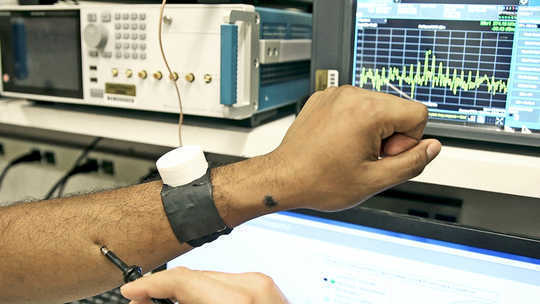{vembed Y=NHqfT1vIe6E}
It’s possible for someone to hack into your pacemaker or insulin pump and potentially kill you, just by intercepting and analyzing wireless signals. This hasn’t happened in real life yet, but researchers have demonstrated for at least a decade that it’s possible.
Before the first crime happens, engineers have tightened security on the “internet of body.” Now, the network you didn’t know you had is only accessible to you and your devices, thanks to the new technology.
“We’re connecting more and more devices to the human body network, from smart watches and fitness trackers to head-mounted virtual reality displays,” says Shreyas Sen, an assistant professor of electrical and computer engineering at Purdue University.
“The challenge has not only been keeping this communication within the body so that no one can intercept it, but also getting higher bandwidth and less battery consumption,” he says.
 The human body carries electrical signals well. Now, new technology can contain these signals within close proximity to the body. (Credit: Erin Easterling/Purdue)New technology keeps your body’s electrical signals contained, which can protect medical devices like pacemakers from hacking, researchers report.
The human body carries electrical signals well. Now, new technology can contain these signals within close proximity to the body. (Credit: Erin Easterling/Purdue)New technology keeps your body’s electrical signals contained, which can protect medical devices like pacemakers from hacking, researchers report.
Body fluids carry electrical signals very well. So far, so-called “body area networks” have used Bluetooth technology to send signals on and around the body. These electromagnetic waves can be picked up within at least a 10-meter (roughly 33 meters) radius of a person.
Sen’s team has demonstrated a way for human body communication to occur more securely—not going beyond a centimeter off the skin and using 100 times less energy than traditional Bluetooth communication.
 The new device prevents hackers from compromising medical equipment such as pacemakers. (Credit: Debayan Das/Purdue)
The new device prevents hackers from compromising medical equipment such as pacemakers. (Credit: Debayan Das/Purdue)
This is possible through a device that couples signals in the electro-quasistatic range, which is much lower on the electromagnetic spectrum. The researchers are working with government and industry to incorporate this device into a dust-sized integrated circuit.
Through a prototype watch, a person can receive a signal from anywhere on the body, from the ears all the way down to the toes. The thickness of your skin or hair also doesn’t really make a difference in how well you carry the signal, Sen says.
The idea would be to create a way for doctors to reprogram medical devices without invasive surgery. The technology would also help streamline the advent of closed-loop bioelectronic medicine—in which wearable or implantable medical devices function as drugs, but without the side effects—and high-speed brain imaging for neuroscience applications.
“We show for the first time a physical understanding of the security properties of human body communication to enable a covert body area network, so that no one can snoop important information,” Sen says.
The work appears in the journal Scientific Reports. The technology has received multiple patents through the Purdue Research Foundation Office of Technology Commercialization. The Air Force Office of Scientific Research YIP Award and the National Science Foundation CRII Award supported the research.
Source: Purdue University
Related Books
at InnerSelf Market and Amazon


























